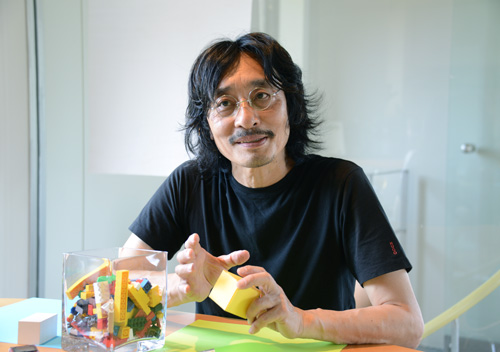
from Japan vol. 64 2013.11.07 Learning should be more fun and radical! - "Learning 3.0" proposed by a workshop guru
![]()
Many organizations from companies, schools, and hospitals to local governments have begun to host workshops to provide training and to encourage communication. Some of these workshops are designed for children to help them express themselves better and to help nurture their imagination through art. The increase in the number of workshops may be a sign that the learning culture is changing from a solitary pursuit for knowledge to a communication platform for many people who share similar interests.
Mr. Nobuyuki Ueda, professor of Contemporary Social Studies at Doshisha Women’s College of Liberal Arts, has been studying the relationship between learning and workshops from the 1970s, before the English word “workshop” became widely known in Japan. Cherishing the concept, “playful learning,” he has continued to explore the possibilities of alternative learning.
Mr. Ueda believes that learning has evolved from something we do individually (learning 1.0) to something that is enriched through interaction with others (learning 2.0), and now it is about to move to the next level. To find out more about the future of learning, I went and visited Mr. Ueda at the New Museum in Yoshino, Nara. (Written by Atsuko Koizumi)
目次へ移動 First encounter with Sesame Street
The Neo Museum is an experiential atelier built by Mr. Ueda. A welcome breeze passes through this very green building, which offers a panoramic view of the Yoshino River. Many visitors have met new people and have been inspired by the things that they learned here.
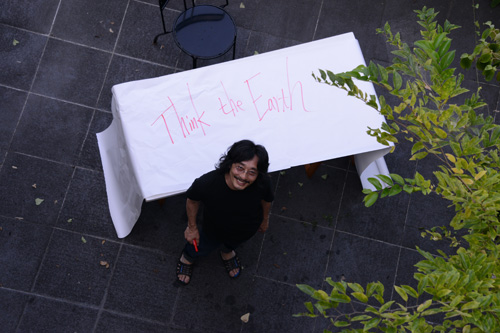 The Neo Museum is located in Yoshino, Nara. Mr. Ueda makes it a point to welcome his guests with a welcome board.
The Neo Museum is located in Yoshino, Nara. Mr. Ueda makes it a point to welcome his guests with a welcome board.
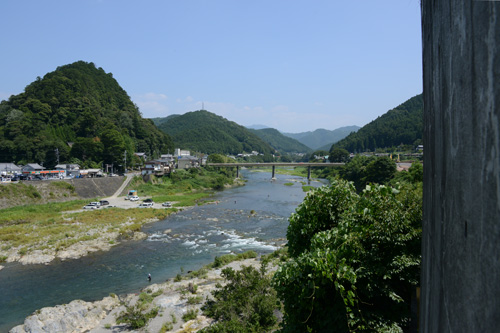 The view from the Neo Museum window.
The view from the Neo Museum window.
Mr. Ueda saw his very first episode of Sesame Street when he was a junior in college. The show had just begun to be broadcast in Japan. That was when he became very interested in learning. The program fascinated him - how it taught children the alphabet and numbers with singing puppets. Teaching in Japan around that time was a more unilateral process. Teachers tried to stuff children's heads with as much information as possible. Mr. Ueda explained that it was quite a shock to him when he realized that "Education can and should be fun!"
"Sesame Street" has proven that making learning fun is very effective. Until this program came about, there wasn't much interest for children's education in the United States, but research with over 1,000 subjects has shown that children who watch "Sesame Street" better recognize letters and numbers in comparison to children who do not.
When Mr. Ueda, who used to play in a folk band and had interest in the entertainment and TV industry, saw this program he thought, "This is exactly what I want to do!" This is also when he decided to study abroad, in the U.S. He majored in audio-visual education at the graduate school of the Central Michigan University, but if truth be told he was struggling with the language barrier, so his life as a Japanese student in Michigan was far from fun.
Having said that, he was given a great opportunity during Christmas break in the U.S. to visit the "Sesame Street" production suite in New York. Back then the program was produced by the nonprofit organization, Children's Television Workshop (CTW, now known as Sesame Workshop). Mr. Ueda explained that it was really like a fun workshop. The team was working together excitedly, exchanging their views to create these episodes. They seemed to be having a lot of fun, but this does not mean that they weren't taking it seriously. They tested a lot of different things to see what worked best with all seriousness, but still managed to make it fun. This is the wellspring of Mr. Ueda's motto, "playful learning."
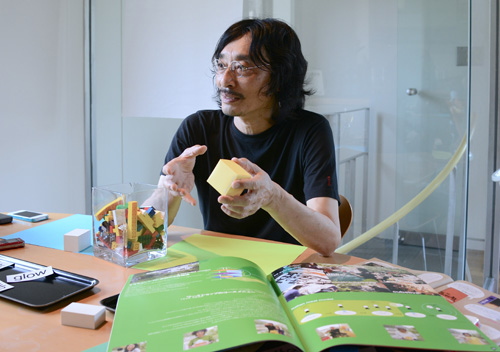 His first encounter with "Sesame Street" opened his eyes to a whole new way of learning.
His first encounter with "Sesame Street" opened his eyes to a whole new way of learning.
Having been reminded of what it was he wanted to accomplish all along, once he finished graduate school at Central Michigan University, he enrolled at Harvard University Graduate School of Education to study under Professor Gerald Lesser, who served as one of the chief advisors to CTW helping develop the program's curriculum. During his second time around at Harvard some 6 years later, he met Mrs. Carol Dweck, a professor of psychology, who strongly believed that "Talent is developed, not given" and Professor Seymour Papert of Massachusetts Institute of Technology, who is renowned for having developed the LOGO programming language.
His brush with Professor Papert's philosophy changed his life. LOGO was created as a tool to help improve the way children think and solve problems. Children learned while giving instructions to the little turtle robot on the computer screen. For example, if they tell the turtle to go "Forward 100," "Right 90" 4 times, they'll end up with a rectangle. If the turtle doesn't move the way they want it to (when there's a bug), the children try to figure out why and to fix (debug) the problem.
"Professor Papert used to say that a bug wasn't a failure. If the turtle moves in the wrong direction, all you have to do is fix it. What's important is not that you get the answer right, but how you fix it. But this wasn't what was being taught at schools in Japan."
The program helped teach children to think, test out their idea, and to fix problems. Through this process, Children gained procedural knowledge about "rectangles."
Another thing Mr. Ueda learned from Professor Papert is to "think about what it means to think."
You can't think about thinking without thinking about thinking about something.
"This sounds like a riddle, but personally, I like to replace the word 'think' with 'learn.' 'To learn about learning.' Before, we used to think that we learned to accomplish a goal, like getting an A+ on a test or getting into a good school. But learning itself should be a goal. By learning you grow, and your growth should be the fruit of your labor."
目次へ移動 To be playful means to be serious
The words, "playful learning," well describe Mr. Ueda's passion for learning. In his book, "Playful Thinking" (published by Sendenkaigi), Mr. Ueda defines what it means to be playful:
1. Being playful means to be serious
2. Being playful means to be flexible
3. Playfulness as an engine for collaboration
4. Being playful means to be excited about something you feel you can achieve
"In play lies the true potential to learn. But it can't be all about fun. It has to pique your interest, and make you want to seriously get involved. You can't become passionate about something or completely absorbed unless you are serious. Nothing creative comes from doing something reluctantly. That is why learning based on interest or passion is important."
Mr. Ueda would also like to make the English word, "learning," more widespread in Japan.
"There are several Japanese words that can have the same meaning as the English word, 'learning,' but they tend to remind us of school education and studying at school, so it's hard to imagine that learning could be fun. It is difficult to define 'learning' with a single word, but you could say that learning is about discovering new worlds or something about yourself. In other words, learning provides opportunities to maximize your potential. English words like media and design have become a part of the Japanese language, but I hope that one day learning will, too. This will help create and share a new image of learning."
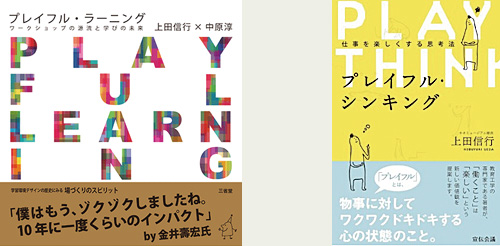 Mr. Ueda's books, "Playful Thinking" (Sendenkaigi) and "Playful Learning" (Sanseido).
Mr. Ueda's books, "Playful Thinking" (Sendenkaigi) and "Playful Learning" (Sanseido).
目次へ移動 Performing on stage with learning 3.0
So where is this new world of "learning" heading?
"I call conventional school education with teachers 'learning 1.0.'"
"Next came the era of 'learning 2.0.' This is not something that is given to you by someone else, but something you do on your own by interacting with others through, for example, workshops and group work. Even with work, you're more likely to come up with a creative idea when you're working collaboratively with others. And when you're doing so, your relationship with the other team members is equal."
"I believe that the dawn of 'learning 3.0' is right around the corner. This will be more theatrical, where learners are like performers, who want to put on a fantastic performance to entertain the audience. Because it'll be fuelled by passion, '3.0' will provide a deeper, richer learning experience. For example, if you go to a professional musicians' live performance, there will be a large crowd that help create an awesome ambience. This synergy effect helps make the music sound even better. TED is another such example. They get great presenters, there is a great audience, and the videos they share online share the fantastic experience with many people around the world."
"Think about it this way. 'Learning 1.0' is like practicing to play the guitar on your own. '2.0' is when you join a band, and '3.0' is standing on stage and performing for the fans. You can't really get better simply by practicing by yourself. What is important is to use the stage as a tool, and to have passion for what you're doing. For writers, literary awards such as the Akutagawa and Naoki Prize (which are like the Pulitzer Prize) are stages. And nowadays, anyone can put on a performance for the world using YouTube."
"In other words, what we need in the future are performing 'stages = where people can get serious.' To be serious means to be playful, and the task that lies ahead of us is creating more stages that can get people excited."
When Mr. Ueda organizes a workshop, he makes sure to take photographs and videos. This is not only for archive purposes. This helps participants become aware that they are being filmed and to create a healthy level of nervousness. He is helping to create a stage.
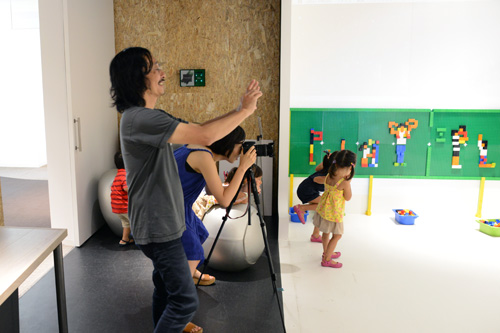
目次へ移動 A museum without exhibits
Mr. Ueda has thought for a long time now that "watching learning" take place is equally important. That is why he created the Neo Museum in Yoshino, Nara in 1990. As the word "New" indicates, this museum has made a clear departure from conventional museums. First of all, it doesn't have anything on exhibit. It is a museum where people can come and see activities or communication take place. Today, the concept doesn't sound so far fetched, but the museum was established 20 years ago. Some people were critical. They said that you couldn't really call it a museum, but Mr. Ueda was sure that there would come a time when you could have "learning on exhibit."
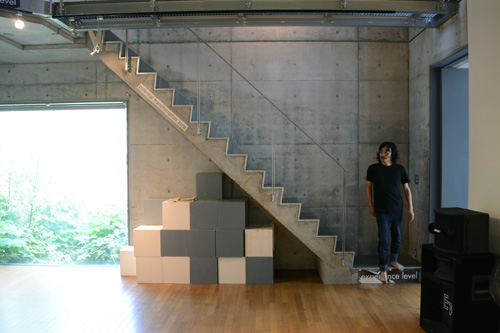 The first floor of the Neo Museum is a floor of experience. This music studio like space transforms into a place of exchange and interaction.
The first floor of the Neo Museum is a floor of experience. This music studio like space transforms into a place of exchange and interaction.
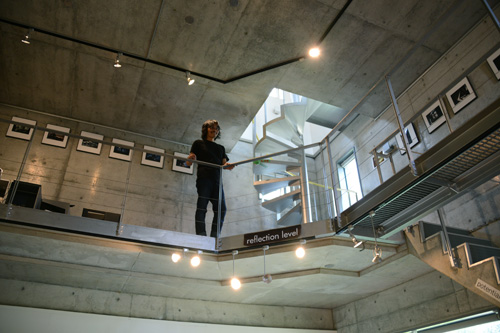 The second floor is for reflection. It's also a gallery from which visitors can watch workshops take place.
The second floor is for reflection. It's also a gallery from which visitors can watch workshops take place.
目次へ移動 Ask radical questions
An event known as the "Party of the Future" has been held every May, ever since the museum opened. In recent years, students from Professor Ueda's seminars at the Doshisha Women's College of Liberal Arts have worked together with students from other universities to plan this event. Every year, the event attracts nearly 100 people who take part in discussions about the future of education and design. To get to Yoshino, it takes about 5 hours from Tokyo, and more than 2 hours from Osaka or Kyoto, so it's a bit of a journey, but many have felt that being away from their normal life has helped them have a richer, deeper experience.
Mr. Toshihiro Kanai, Professor of Organizational Behavior at the Kobe University Graduate School of Business Administration, who took part in the Party of the Future in 2011, describes the event on his university webpage as "having rocked my beliefs to its foundations and changed my outlook on life in a good way."
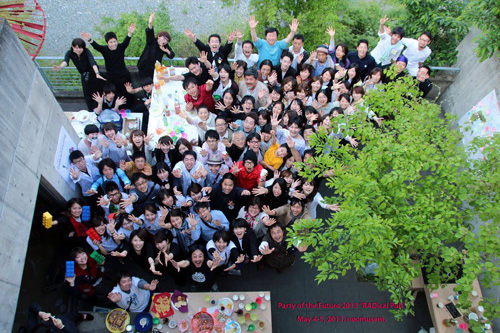 One hundred people took part in the Party of the Future held in May 2013 (photo courtesy of Neo Museum).
One hundred people took part in the Party of the Future held in May 2013 (photo courtesy of Neo Museum).
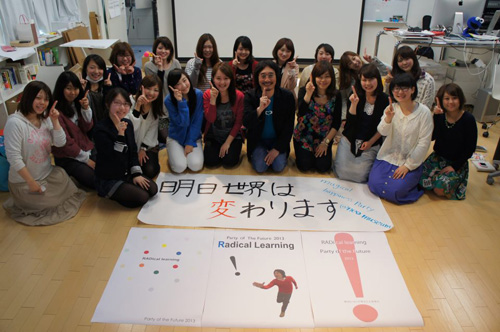 Students of Mr. Ueda's seminar run the Party. Experiencing running a big event helps build their confidence (photo courtesy of Neo Museum).
Students of Mr. Ueda's seminar run the Party. Experiencing running a big event helps build their confidence (photo courtesy of Neo Museum).
The theme of this year's Party of the Future was "Radical Learning." When people think about the word radical, they may think that it's "extreme," but the word also means, "fundamental, or to go to the source." Mr. Ueda believes that learning essentially means to ask radical questions.
"Not only do we want to ask radical questions about school education, we also want to ask radical questions about life in general. Asking such questions and giving shape to ideas is like creating art. That's why I think learning is also like art."
Mr. Ueda refers to himself as a learning artist.
"When you think about designing learning, it may sound like there is a problem, and you're trying to think of a solution that addresses this problem. But with learning art what's important is not finding a solution, but what questions you ask."
Mr. Ueda has been thinking about what "learning" actually means for nearly 20 years now. But there isn't an answer to this question. Art takes many forms. Mr. Ueda believes "learning 3.0" is important because it serves as a tool for asking radical questions.
目次へ移動 The key ingredient of workshops is hospitality
What qualities are important in producing a learning workshop? I asked Mr. Ueda about the criteria workshop facilitators need to meet.
"Basically, workshop facilitators need to be hospitable and sincere. They need to always think about how they can help enrich the participants' experience. This is the kind of spirit that facilitators need to have."
To do so, facilitators need to learn to take a step back and to look at things from various angles.
"I think it's kind of like being a football fantasista. Because they don't know from which direction the ball is going to come, footballers move around the pitch freely, trying to keep an eye on everything that is going on on the pitch. While running at great speeds, they try to have a bird's eye view of the game to keep the ball in control."
Mr. Ueda, too, is extremely considerate to others around them. He was very hospitable at all times during the interview and the workshop, making sure everyone there was comfortable. One of the students of his seminar at the Doshisha Women's College said, "Professor Ueda's classes are very different. With classes that have many students, the dialogue is usually 1 (professor) against many. But in Professor Ueda's class, although he is talking to all of us in the room, it feels like he's talking directly to me." Many of his students seem to feel this way. Its easy to imagine he is considerate to each and every student in his classroom.
Mr. Ueda also believes "experience" and "magic" are key to becoming a good facilitator.
"It all boils down to experience. This is not something you can gain from reading a manual or by taking part in training programs. It's like cooking. Practice makes perfect. That's why it's important to take part in as many workshops as possible. Students often ask me how they can get better at organizing workshops, but it's really difficult to explain. When organizing a workshop, there's a moment when everything seems to glow. I ask my students, 'Do you know what I mean? That's the moment I'm waiting for!' So how do we design an environment where this could happen? That's what I want my students to think about."
"How can you cast a magic spell over the participants so that they will be able to really get into the workshop? I like to start with dancing. This is a type of magic. It's important to get your body moving to awaken your mind, but when you get people dancing to loud music, this helps instill a sense of unity. The atmosphere changes when we start out by having everyone help clean, or serving a cold drink in a frosted cup. For example, watching a film at home and a movie theater is different. When you watch a film at a movie theater, you can totally get into the world on the screen. So designing activities, tools, and the scene is like designing a magic spell. You create an environment that is different from everyday life to cast the magic spell."
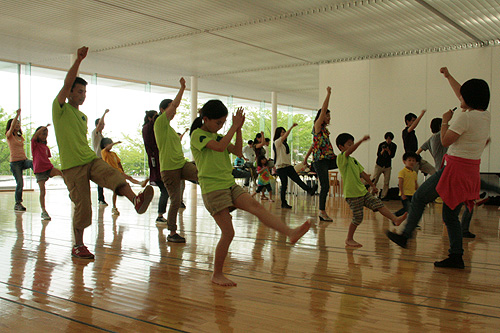 A scene from a music and video workshop designed for parents and children organized at the SCSK group's CAMP (Okawa Center) in June. Getting everyone dancing is one of the magical spell. (Photographed by: Atsuko Koizumi)
A scene from a music and video workshop designed for parents and children organized at the SCSK group's CAMP (Okawa Center) in June. Getting everyone dancing is one of the magical spell. (Photographed by: Atsuko Koizumi)
Props are very important in casting a magic spell. "Motivation alone can't get people in the mood. You need props." So, let us introduce some props that Mr. Ueda uses.
*Balloons
Mr. Ueda asks participants to blow up balloons and write a message or a description about themselves. When you think about what to write on the balloon, you don't really think negative thoughts, and you also don't have much space to write. That is why balloons are great tools that allow people to instinctively express themselves. Moreover, these balloons bearing fun, intuitive comments help create a relaxing environment. You can also conduct an experiment to see how balloons as a medium affect communication.
*Cube
Participants may be asked a question, like "What is learning to you?" and they would write down their answers on each side of the cube (5cm2 paper cube). The answers could be anything, like "maturing knowledge," or "something you do with others." Since the cube has 6 sides, people think of 6 answers to each question. Then the participants can trade cubes and offer each other feedback. And although cubes have different sides, as you spin it around in your hands while expressing your ideas, you begin to see how your ideas are connected. What's more, writing your ideas down is a way to "externalize" your thoughts. By sharing your thoughts, you can "think and reexamine" your own ideas.
Mr. Ueda also argues that workshops can't be fun if it's not an experiment. Recently, he has begun to focus on the "unprepared mind." He believes that when people prepare too much, they tend not to push the boundaries, and therefore interesting ideas don't emerge.
"Nowadays, workshops are conducted for training purposes, but this really isn't the essence of workshops. New discoveries are made because you take an experiential approach to tackle a problem to which no one has the answer. But if you give participants too much time to prepare, the problem then becomes an agenda, and when you become too bound to the agenda, you can lose sight of what's going on in front of you."
"Not preparing doesn't necessarily mean that you don't plan. Planning is important. But the biggest variable of workshops is the participants. You can't design the workshop in advance, because you don't know who is coming. Participants have different needs, so you need to be able to embrace the situation and make adjustments if necessary." 」
"Comedians make it a habit to be on the lookout for ideas for their jokes. I tried to get people to cultivate a similar mindset, attitude. So you could say that you're preparing every day. Even if the idea is great, if the activities aren't fun, it won't work. You need to be able to objectively evaluate how the workshop is being received."
目次へ移動 PLAY PLAY PLAY
September 1, 2013. Amid the lingering summer heat, my daughter and I took part in "BRICK 3.0 - PLAY PLAY PLAY" a workshop designed for children and their parents, held at the Park Homes Imagination Museum in Tsukishima, Tokyo. The workshop was conducted by Mr. Ueda and the museum curator, Ms. Keiko Onishi.
The word, PLAY, was projected on the white wall of the museum. "Let's make an animation using blocks!" - this was the only description of the workshop that was made available. So we didn't know what we were going to do until the workshop began.
Ten participants from 10 people from 4 families took part in the workshop we went to. "Let's all dance!" said Mr. Ueda as he began to step to the music. We all started dancing to the original piece of lively music created by a musician in New York, and in no time we were all smiling.
Next, we recreated the word, PLAY, projected on the wall with our own bodies and took a photograph. Then the photo was projected onto the wall, and we tried to create a likeness using blocks. The blocks were large, so we weren't trying to replicate the image exactly; rather, we were trying to layout the blocks in a way that made them look like people.
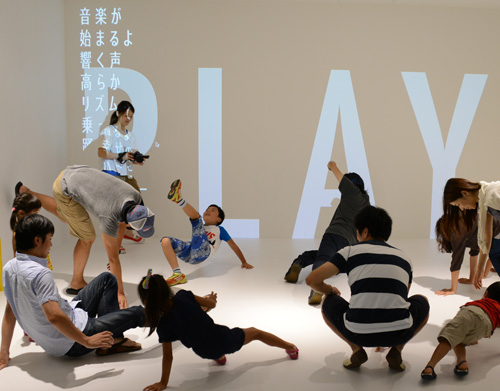 First we danced to some music.
First we danced to some music.
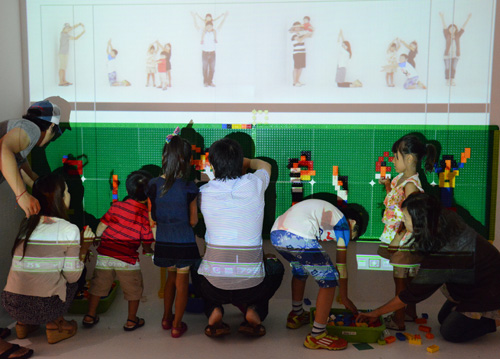 We tried to replicate the image while looking at the photograph projected on the wall. The process stimulated our senses in a different way than usual, so it was fun for adults, too.
We tried to replicate the image while looking at the photograph projected on the wall. The process stimulated our senses in a different way than usual, so it was fun for adults, too.
After the first exercise, each family came up with 2 more dynamic poses and took photographs. The image was then projected onto the wall and recreated using blocks. Then these block reproductions were photographed and looped back to back, and voila, we ended up with a unique animation. Visual artist, Mr. Yusuke Shigeta, edited these photographs on the spot for us. "Oohs" and "aahs" escaped from the lips of the participants who saw the completed work.
Five workshops were held over 3 days, and every workshop was an experiment. There wasn't a detailed time schedule. Greater importance was placed on being flexible. Many small children took part, and as small children do, some became bored halfway through. But I'm sure they'll remember the day as having been fun because they did something completely new. They saw the blocks they had created come to life.
Participants can also relive their experience by watching the finished video on YouTube. Even when we got home, my daughter kept saying that she wanted to go see the blocks again. I saw firsthand how playful experiences help form the first step to learning.
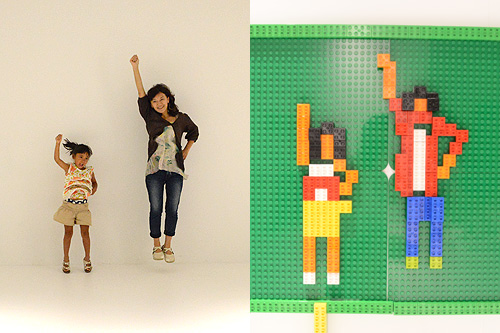 The participants reproduced their movements with Legos and enjoyed the animation that was created.
The participants reproduced their movements with Legos and enjoyed the animation that was created.
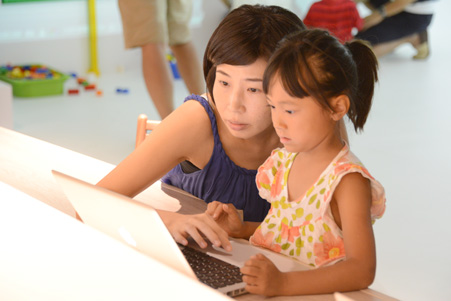 Learning designer, Ms. Keiko Onishi (left).
Learning designer, Ms. Keiko Onishi (left).
A documentation video for "BRICK 3.0." Participants can relive their experience by watching the video.
目次へ移動 Building a children's museum
Mr. Ueda, who has organized many workshops, says, "I want to create a workshop that no one has ever experienced before."
"Actually, there is so much more that I want to do!" Mr. Ueda, who has lead the way in learning wants to transform workshops into a place where "we could have an even deeper conversation. I would like to design a workshop that's like a philosophers' café, a place of learning that is radical and full of wonder, a refreshing workshop without an agenda. I think from now on participants will come not based on what we do, but who will be taking part."
For Mr. Ueda, who has continued to seek a new style of learning, although the shape may be changing, the nature of what he is trying to do remains the same.
Mr. Ueda wishes the national children's museum with learning art institute will be built some time.The Neo Museum has served its purpose as a place of experimentation, so now he wants to plan exhibitions on learning and help paint a bright picture for schools for the future. There are many graduate schools of education around the world, but there are no professional schools where you can study learning. Perhaps the day that the English word, "learning," takes root in Japan is not so far away.
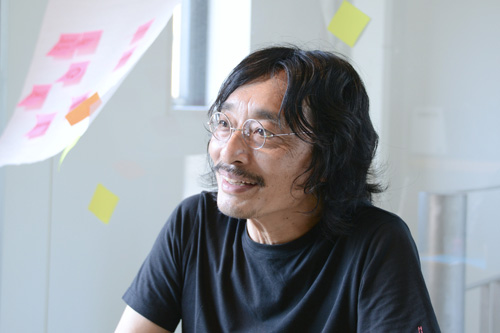
I would like to finish this piece with a message from Mr. Ueda, who has continued to shake the foundations of learning. The desire to learn is in our very nature, so I hope that this message will reach many people, and inspire them to continue their quest for learning.
Learning will rock you!
Atsuko Koizumi biography
At the publishing firm she currently works at, she wrote and edited news articles for a many years, before she moved on to nonfiction and business books. She is now in charge of promotions and PR. She hopes to introduce minor yet newsworthy activities that usually do not get featured with a multifaceted perspective.
Report by: Atsuko Koizumi
Photographs by: Soichi Ueda(Think the Earth)
Translated by: Yuri Morikawa (oxygen inc.)















